#the initial doodle was too happy so i made it spooky
Photo
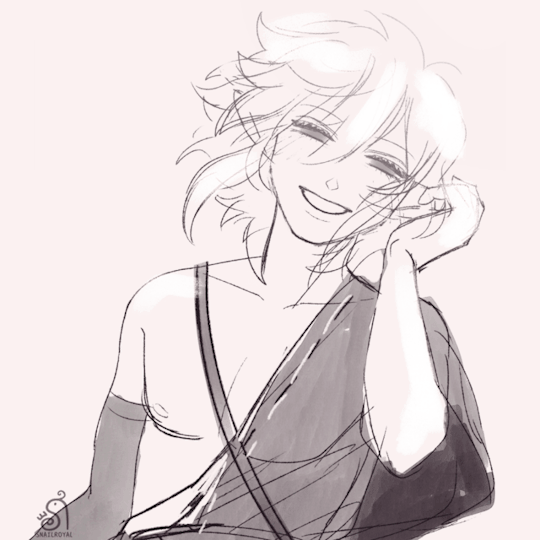
⚠ Warning flashing images // .do you remember?
#botw2#botw#breath of the wild#Link#legend of zelda#LoZ#Linktober#spookymonth#doodle#snailroyalART#the initial doodle was too happy so i made it spooky
92 notes
·
View notes
Photo
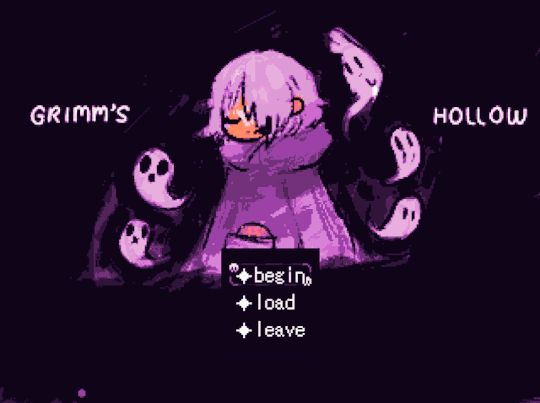

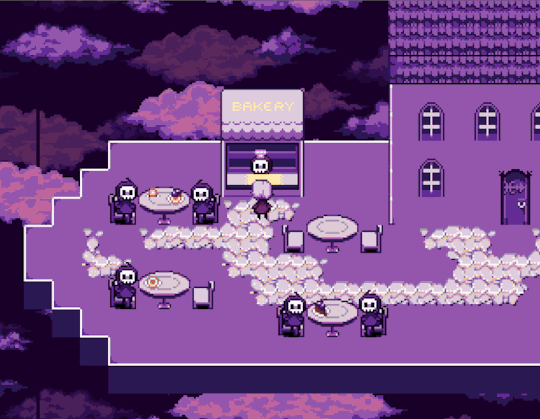


November’s Featured Game: Grimm's Hollow
DEVELOPER(S): ghosthunter
ENGINE: RPG Maker 2003
GENRE: Indie RPG, Adventure
WARNINGS: Discussions of death, losing a loved one, grief
SUMMARY: Grimm’s Hollow is a spooky, freeware RPG where you search the afterlife for your brother. Reap ghosts with your scythe, explore haunted caves, and eat ghostly treats on your journey through death.
Download the game here!
Our Interview With The Dev Team Below The Cut!
Introduce yourself!
*BB: My name's Bruno and I did some of the music along with Nat! I’m super happy to have participated in this game!
*NW: I’m Nat Wesley, a.k.a. Natbird! I’m a composer available for hire with a few projects in the works. I’m honored to have had the chance to work on the soundtrack to Grimm’s Hollow!
*GH: Hello! I go by ghosthunter online; I started developing RPGs with a friend in school when we found out that we both enjoyed RPG Horror. I enjoy art, webcomics, cartoons and narrative-driven indie games a lot. I bought RM2K3 on sale and started pouring pixel art into it, before learning how to do things like chase scenes, cutscenes, etc. I used to fantasize about making my own game, drawing dungeons and ghosts in the back of my sketchbooks, before I finally started Grimm’s Hollow.
Now I’m near the end of high-school, and I’m hoping the best for uni!
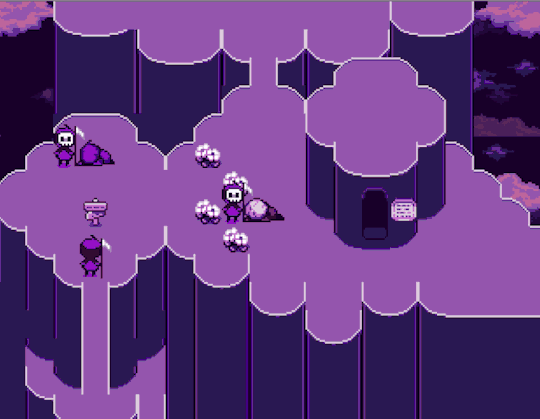
What is your project about? What inspired you to create this game initially?
*GH: Grimm’s Hollow, originally, wasn’t as ambitious or personal. It was simply just going to be “my first game”, something that I could finally put my doodles and RM2K3 skills to. I wanted a game that a younger me would have enjoyed, back when I first discovered the classic RPGMaker games and replayed them constantly for those endings. That was my initial inspiration.
It eventually evolved into an action turn-based RPG that relies on timing, yet it’s mostly narrative-driven. You traverse death in search of your sibling, and try to make an escape. There are unexpected pieces of me that ended up in this game, some of which I’m still noticing even now.
How long have you been working on your project?
*GH: Since the summer of June 2018.
Did any other games or media influence aspects of your project?
*GH: Standstill Girl, OFF by Mortis Ghost, Undertale, Over The Garden Wall, and the animation medium in general.

Have you come across any challenges during development? How have you overcome or worked around them?
*GH: Many! Making your first game is such a giant learning curve, that the list of challenges goes on. I would say that the most difficult issue I encountered (and that, in some ways, I am still facing after release) is working around the limitations of the game engine I am using. I wanted to see whether creating an engaging but simple 1-party RPG in RM2K3 (without going completely custom) was feasible, and I experimented with quick time events as part of that. I worked around the engine’s built-in formulae so players could see progress when they upgraded their stats - although the game might display as defence as “10”, in reality the game stores it as 40 since the engine splits defence by 4. Since I did not want to create an RPG which was too complex for my first game, I also scrapped traditional staples such as armour or weapons. There were also issues such as having an appropriate “game over” handling event which wouldn’t shoot you back to the title screen after you lost a battle; getting RM2K3 to play a small cutscene where you faint and respawn somewhere else was tricky. I felt that if the player had to reload after a loss, it would disrupt the game flow.
Have any aspects of your project changed over time? How does your current project differ from your initial concept?
*GH: Like I mentioned before, the game started off impersonal.
I just had a soft spot for a spooky cute aesthetic, and I wanted to indulge in that. It was (and in its essence, still is) meant to be a short story, to keep the player invested for the short game length - nothing grandiose.
The original draft did not have Baker play a role in the narrative - he was just an ordinary shopkeeper NPC.
For a long time during development, Lavender did not even have a name. In the very first draft, she was a silent protagonist the player could name and customize. But she played a very active role in the final outline, so it was hard not to give her own unique voice when one emerged from the narrative naturally. I am glad I did; she grew on me quite quickly!
Grimm was virtually unchanged from beginning to end. The only difference was that a close friend suggested that he seemed like he would be into drinking Oolong tea - so that’s what he offers you when you meet him.
Timmy also did not go under massive overhauls like Lavender and Baker did, but his relationship with Lavender became much more fleshed out as I wrote the narrative.
In other facets of the game’s design, there were not many changes to the original prototype.
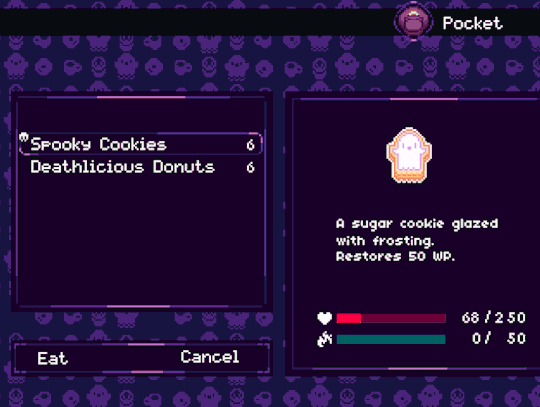
What was your team like at the beginning? How did people join the team? If you don’t have a team, do you wish you had one or do you prefer working alone?
*GH: It was just myself, doing the art, writing, programming, etc. But halfway through creating the second cave, I realised I would need a very specific sound for Grimm’s Hollow. So, I contacted Nat for music, but I also created a post on tumblr calling for a composer since there were many tracks to make. I met Bruno as a result! I am very happy with their work and I am so grateful I’ve got to work with them! (Some players are asking for an OST release, which is in the works).
What is the best part of developing a game?
*GH: I really enjoyed the early stages of development: creating new tilesets, sprites and maps and piecing them together in the editor, then taking a small screenshot and sharing it with my friend over summer vacation … It was nice to see the game’s world slowly come together. I think that’s what I enjoyed the most from beginning to end: that sense of world-building, that sense of relaxation from making a small cosy game. The latter started to disappear as work and other responsibilities started to intrude, and pressure began to seep into development time - but I never stopped loving making the world and characters.
I also want to say that, by lucky chance, I have met a lot of kind people from making my first game. I’m very grateful for that, so thank you to everyone.
Do you find yourself playing other RPG Maker games to see what you can do with the engine, or do you prefer to do your own thing?
*GH: All the time! Other RPG Maker 2003 projects are great inspirations for pixel art tilesets, as well as how to code harder features such as custom menus. They’re also just fun to play.
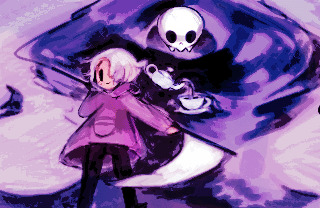
Which character in your game do you relate to the most and why? (Alternatively: Who is your favorite character and why?)
*GH: Lavender and Timmy are relatable to me in multiple ways. I can’t elaborate on Timmy since that would go into spoiler territory, but I somewhat relate to Lavender’s insistence on managing her life on her own - sometimes to her own detriment.
I’d say the most fun character to write for was Grimm. He can be unintentionally silly while speaking in the most formal way, but also very caring too. Everything he does and says was easy to write, whereas I had to think harder for the interactions between everyone else - especially for very crucial scenes regarding their development. That being said, my favourite is still the game’s central two siblings. I can not pick between them for the life of me.
Looking back now, is there anything that regret/wish you had done differently?
*GH: I wish I started testing even earlier! Not only does it give you a good sense of what’s missing, but seeing people enjoy what you’ve made yet get hindered by bugs is a very strong incentive to fix your game immediately. When I was lacking motivation or was stuck, I found that good feedback and support made me motivated again.
I also wish that I could have pushed the deadline a little further, or perhaps released the game on Early Access since it will take me a while to refine post-release bugs - but as it is, the 31st of October really was the deadline for my game due to external circumstances (no, that deadline wasn’t just because it was Halloween!).
Other than that, I wonder if using an updated version of RPG Maker would have produced the same game …? It’s hard to tell, but I hope people enjoy it for what it is - I will be working on that post-release patch soon!
Do you plan to explore the game’s universe and characters further in subsequent projects, or leave it as-is?
*GH: There are no current plans, but I would be happy to have the opportunity to improve and expand on the game. As it is, the game’s released for free and done as a hobby, so I would struggle to do that by myself.

What do you most look forward to now that you have finished the game?
*GH: Earlier on, I was really looking forward to players’ reactions. Games are made to be fun, and I would have felt distraught if my game didn’t achieve what it was set out to do. Yet it was not just about the gameplay; it was about the narrative. I hoped that what I found funny, the player would too; what was heartfelt to me, was heartfelt to the player as well. Like sharing a laugh, or just a good experience together. I hoped they would enjoy the feeling that went into it, despite the struggle of making it against circumstance and limitations.
Now, I look forward to resting and sleeping once this over. I want to explore my other interests, improve, and explore new media. I want to relax, and refocus again like I was before the heat of development.
Is there something you’re afraid of concerning the development or the release of your game?
*GH: Bugs! Some are easy to fix, but others are harder due to the limitations of the engine (e.g an error in one ending is caused by an overflow error).
Do you have any advice for upcoming devs?
*GH: Show your game as early as possible, to as many people as possible. As soon as you have something playable, it’s ready for feedback. You’ll see if that game mechanic you spent hours refining works, or if it doesn’t work and why. You’ll understand what players enjoy and what they want more of, but also what they don’t like or don’t enjoy.
And you will definitely encounter bugs. You’ll be able to pinpoint and fix minor problems early on that can easily become a larger issue later. You’ll be able to fine-tune your game so its best bits shine, and the difficulty is just right.
Question from last month's featured dev @dead-dreams-dev: Is there anything you’ve added to your game for no other reason than because you’re hoping fans will get a kick out of it? Fanservice, fourth wall breakage, references to other games, jokes, abilities that are just ridiculously overpowered and badass, etc?
*GH: It’s hard to say; game design is trying to find the intersection between what’s good for the player, what the developer enjoys, and what’s feasible to implement. Every decision made should be conscious of that … I think a lot of the game’s early light-hearted jokes was not only made because I enjoyed it, but I hoped the player would “get a kick out of it” too. But more so, I think it’s because I would struggle to write a story which is serious and bleak from beginning to end. The game is a little self-indulgent in the narrative that way.
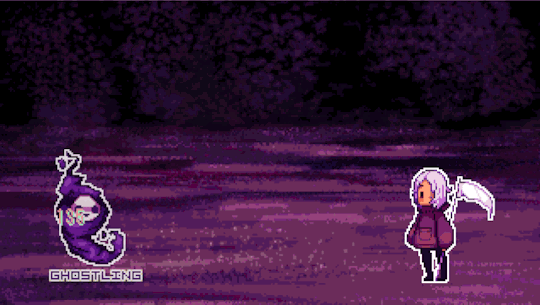
We mods would like to thank ghosthunter & team for agreeing to our interview! We believe that featuring the developer and their creative process is just as important as featuring the final product. Hopefully this Q&A segment has been an entertaining and insightful experience for everyone involved!
Remember to check out Grimm's Hollow if you haven’t already! See you next month!
- Mods Gold & Platinum
#rpgmaker#rpg maker games#indie games#pixel games#rpg#adventure#cute#grimms hollow#grimm's hollow#gotm#game of the month#gotm 2019#2019#game of the month 2019#november#november 2019
983 notes
·
View notes
Text
Disney’s Haunted Mansion at 50: The Ghosts Are Still Grinning
One summer visit to Disneyland after another, a young Tom Morris stood outside a mysterious set of locked gates, peering up at a stately, old-fashioned manor sitting just out of reach and wondering what awaited inside.
When those gates in Anaheim, Calif., finally opened in August 1969, Mr. Morris and others entered what became one of the most beloved and long-lasting attractions at any of the Disney theme parks: the Haunted Mansion, a macabre ride filled with mystifying illusions, eerie inhabitants and 999 grim, grinning ghosts, having a delightful time in the afterlife.
For Mr. Morris, who later became an Imagineer (a Disney employee who designs resort attractions), every element of the dark ride was fascinating. There was something about the music — the theme song, “Grim Grinning Ghosts,” plays throughout the ride — the smell of the hydraulics, the “old-fashioned showmanship.” He took a spin through the Mansion twice each trip, a rare sign of dedication back when two rides at Disney required two separate tickets. And he found himself doodling pictures of the ride in class.
Surely, Mr. Morris thought, he was the only one with this level of adoration for the Haunted Mansion. Fifty years later, it’s clear that has never been the case.
The Haunted Mansion, treasured as one of Disney’s quirkier rides, has long maintained a fan-favorite status for its distinct balance of the spooky and the sprightly. Varying iterations of the attraction, including the Dutch Gothic-style Tudor version at Walt Disney World, in Orlando, Fla., have become staples at five Disney resorts around the world.
Other rides over the years have come and gone (and been given face-lifts to reflect recent Disney films). But with remarkably little deviation from the original design, the Mansion has been a constant for five decades.
Mysterious From the Start
Built in the early 1960s to resemble an old New Orleans estate, the Haunted Mansion at Disneyland sat vacant for years — its exterior finished, its insides a mystery. The longer it sat, the more the mystique built. An advertisement at the gate for “post-lifetime leases” hinted at the type of ride future visitors might expect: Inquiring spirits were directed to contact Disneyland’s “Ghost Relations” department.
There were rumors among visitors about what had rendered the house off-limits for park guests. Maybe Disney had already tried to open it as an attraction, but the ride had been too terrifying. Perhaps Walt Disney himself was planning to move in, and the house would never open as an attraction.
In the end, the delays boiled down to something more mundane: Between creating other future favorite rides like Pirates of the Caribbean, breaking ground on a new park in Orlando and getting ready for the 1964-65 World’s Fair, Disney’s Imagineers were simply swamped. After Disney died in 1966, finishing the Mansion became a focus.
A creative debate between the project’s two driving Imagineers, Marc Davis and Claude Coats, inspired the Mansion’s complementary moods. Davis was in favor of a lighter, humorous approach to a haunted house. Coats wanted the opposite.
“The beginning of the attraction is more Claude Coats,” his son Alan Coats said. “It’s scarier, it’s more moody, it’s darker, it’s ominous. You think, ‘Uh oh, this is going to be scary,’ and it does really frighten a lot of people when you enter those doors.”
But as the ride’s vehicles, called “doom buggies,” whisk visitors along, the mood starts to brighten — Davis’s influence. Spirits dance through the ballroom, and the journey culminates in an upbeat graveyard party. For many fans, it’s that combination of fun and frightful that has made the ride a favorite.
“I think the Mansion taps into our wanting to be scared and realizing that we made it through safely, that we were able to overcome our fears and deal with them and come out O.K.,” Mr. Coats said.
Susan Thompson, who lives in Lakeland, Fla., spent her first ride through Disney World’s Mansion in Orlando, as a 5-year-old, crying with her head buried in her mother’s side. When she went back a year later, determined to keep her eyes open, she fell in love with watching the Mansion come alive.
Ms. Thompson, now 51, has since acquired her fair share of Haunted Mansion souvenirs: a dress reminiscent of those worn by Mansion staff and a backpack patterned with the manor’s signature wallpaper, among other items. On her twice-a-month visits to Disney World, she always returns to the ride.
For R.J. Crowther Jr., a bookseller in San Diego, the Mansion is the first attraction he has a vivid memory of riding at Disneyland. He’s since been on it more than 200 times, earning him a certificate from Disney staff that declares him an honorary citizen of the park. Mr. Crowther has also collected an “embarrassing amount” of Mansion merchandise, primarily sculptures inspired by art within the ride.
“When you’re younger, it’s just all real and magical,” Mr. Crowther said. “There’s just something wonderfully otherworldly about it that just captures people’s imaginations.”
Alyssa Ottum, another superfan, is planning a tattoo sleeve composed entirely of Mansion-related images: The exterior of the Disneyland manor is already finished, and pieces with the Mansion’s gothic wallpaper and some of the ride’s most famous characters are in the works.
For the 50th anniversary, Ms. Ottum attended an overnight event at Disneyland, complete with ghoulishly named snacks and photo ops with Mansion characters. Tickets went for nearly $300.
Haunted Memories
The Haunted Mansion’s fans extend beyond the ride’s regulars; it’s a favorite among Disney Parks employees, who are called cast members.
“Everybody that says they want to work for Disney?” said Robert Brauchler, who was a cast member for 16 years at Walt Disney World in Orlando. “Ninety-nine percent of the time, they say they want to work at the Haunted Mansion.”
The work itself isn’t extraordinary. Like those at any other attraction, cast members (clad here in green polyester tuxedos and dresses) still spend hours parking strollers in the Florida heat or loading guests into ride vehicles. What sets this attraction apart is how workers, acting as the Mansion��s eerie butlers and maids, can melt into their somber, creepy characters as part of the ride’s ghoulish aesthetic.
“If you’re having a bad day, that’s a great place to be working,” Mr. Brauchler said. “I would just stare at people and just not smile. It’d be like, ‘Hey! You work at Disney; you’re supposed to smile!’ No, I’m not. I would just walk away from them, and it’s all part of the theming.”
Mansion cast members still find time for more upbeat moments: Mr. Brauchler and another employee would sometimes sneak black-and-white photos of themselves into the picture frames in the ride’s ballroom scene. And when employees at the attraction complete their training, they crawl underneath the “doom buggy” tracks — flashlights in tow — to sign their names alongside hundreds of others on a wall beneath the ride.
Some riders, though, have a different way of leaving a mark. Every once in a while, a cast member discovers gray powder on the floor — the ashes of deceased park-goers who had a particular affinity for the ride, spread by loved ones hoping to add another spirit to the Mansion’s collection of happy haunts.
“It was like, ‘Ugh, somebody spread Grandma on the carpet again,’” Mr. Brauchler said. “We’d have to shut the ride down and go investigate it.”
He added: “All these people that think that their loved ones are going to be in the Haunted Mansion forever? Well, Grandma’s getting vacuumed up into a vacuum and getting sent out to the landfill somewhere.”
But there are plenty of other park-approved memorials at the Mansion. Many Imagineers who worked on the attraction were honored in a mock cemetery at Disneyland bordering the ride queue, its gravestones etched with rhyming epitaphs. (The cemetery was removed to make room for longer lines, but a similar one remains in Orlando.)
“At peaceful rest lies Brother Claude, planted here beneath this sod,” Coats’s reads.
It was a bit too dark for Coats’s wife, their son Alan said. She was not a fan.
Voices From the Beyond
Another Disney employee was immortalized in the ride itself. Madame Leota, the Mansion’s floating head who summons ghosts from inside her crystal ball, is the face of Leota Toombs, one of Disney’s first female Imagineers.
Her daughter Kim Irvine, Disneyland’s art director, was a teenager when her mother was practicing for the role. Toombs was the face of Madame Leota, but not the voice, and Ms. Irvine remembers her mother lip syncing the incantation in front of a mirror downstairs for days.
“One day my friends and I came home, and she was down there doing, ‘Witches and goblins and ghoulies!’” Ms. Irvine said. “They were like, ‘What’s wrong with your mom?’”
Toombs did, however, lend her voice to the end of the ride at the California park, where a small spirit — lovingly called Little Leota by fans — ominously bids visitors adieu. When Toombs died, in 1991, Ms. Irvine’s visits to the ride with her own daughters gave them a chance to hear their grandmother’s voice again.
“I always had to laugh when we would be going up the exit escalator and seeing Little Leota over there going, ‘Hurry back,’” Ms. Irvine said. “And I’d go, ‘Girls, say hi to Grandma, there’s Grandma!’ and I’d hear people around me go, ‘What a weirdo.’”
When Disney decided to create an annual holiday-themed makeover for the Mansion, Imagineers needed to record a new incantation for Madame Leota in order to match the overlay. When they approached Ms. Irvine for the part, she was initially unsure — but she knew she didn’t want anyone else to do it either.
Now, every winter, she and her mother are both a part of the ride.
“I go out in the park in the morning before guests come in to check things out and look things over, and it’s so quiet out there in New Orleans before they turn on the music,” Ms. Irvine said. “But Little Leota never turns off. So to walk by the exit there and hear her little voice just talking away to me makes me smile.”
Sahred From Source link Arts
from WordPress http://bit.ly/31HcCAn
via IFTTT
0 notes